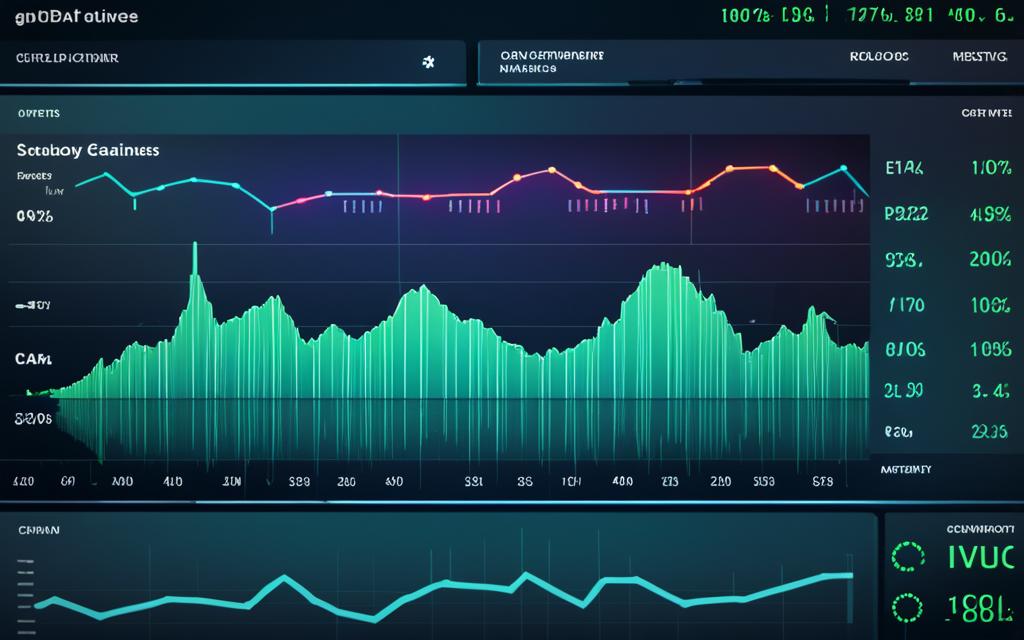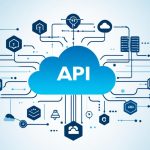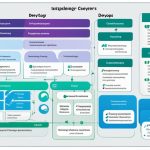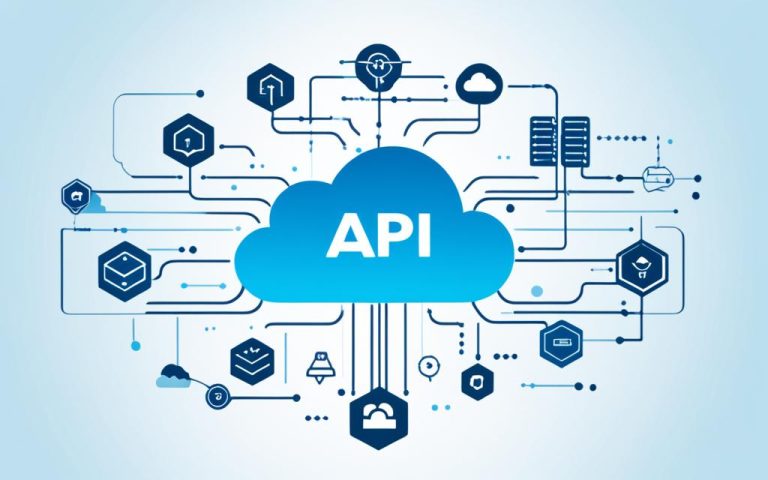Cloud monitoring is an essential aspect of managing and optimizing cloud infrastructure. With the increasing reliance on cloud services, businesses need to ensure the smooth operation and performance of their cloud environments. This is where cloud monitoring tools come into play, providing real-time visibility, network monitoring, and analytics capabilities to help businesses effectively manage their cloud resources.
In this article, we will explore the top cloud monitoring tools available in the market today. Whether you are a small business or a large enterprise, these tools offer valuable insights into your cloud infrastructure, applications, and services. By monitoring and analyzing key metrics, businesses can proactively detect and troubleshoot issues, optimize performance, and make informed decisions about their cloud management strategies.
From built-in monitoring tools offered by popular cloud service providers like DigitalOcean, AWS, Microsoft Azure, and Google Cloud to third-party solutions like Datadog, AppDynamics, New Relic, Prometheus, Dynatrace, PagerDuty, and Splunk, we will cover a range of options to suit different business needs.
Whether you are looking for comprehensive monitoring, integration capabilities, scalability, alerting and reporting features, user-friendly interfaces, security measures, cost management capabilities, or reliable customer support, this article has got you covered.
Stay tuned as we delve into the details of these tools, their key features, and how to select the right cloud monitoring solution for your business. Enhance your cloud management practices, optimize network performance, and unlock the full potential of your cloud infrastructure with these key tools for cloud network monitoring and analytics.
The Importance of Cloud Monitoring
Cloud monitoring plays a crucial role in today’s business landscape as organizations increasingly rely on cloud infrastructure to power their operations. With the help of advanced cloud monitoring tools, businesses can gain real-time visibility into their cloud environment and effectively monitor the performance of their cloud resources.
Real-time visibility is a key advantage of cloud monitoring tools. By monitoring the various components of a cloud infrastructure, including servers, databases, applications, and network performance, businesses can quickly detect and troubleshoot issues that may arise. This proactive approach ensures that potential problems are addressed promptly, minimizing downtime and optimizing performance.
“Cloud monitoring allows businesses to gain real-time visibility into their cloud environment and effectively monitor the performance of their cloud resources.”
Performance analysis is another critical feature provided by cloud monitoring tools. These tools collect and analyze data on resource utilization, service availability, and response times, allowing businesses to assess the overall performance of their cloud infrastructure. Through performance analysis, organizations can identify bottlenecks, optimize resource allocation, and ensure that their cloud environment meets the required performance standards.
Issue detection is a key aspect of cloud monitoring. These tools continuously monitor the cloud environment for anomalies, alerting businesses to potential issues such as high CPU usage, network latency, or security breaches. The early detection of these issues allows businesses to take immediate action, minimizing the impact on operations and ensuring the security and stability of their cloud infrastructure.
Overall, cloud monitoring tools provide businesses with the means to effectively manage and optimize their cloud resources. Whether it is maintaining the performance of critical applications, ensuring the availability of services, or securing sensitive data, cloud monitoring is essential for businesses operating in the cloud environment.
Real-time Visibility
Cloud monitoring tools provide real-time visibility into the various components of a cloud infrastructure, including servers, databases, applications, and network performance. This visibility allows businesses to monitor their cloud environment at any given moment and quickly identify potential issues or bottlenecks.
Performance Analysis
Cloud monitoring tools collect and analyze data on resource utilization, service availability, and response times. This information enables businesses to assess the overall performance of their cloud infrastructure and make data-driven decisions to optimize resource allocation and improve performance.
Issue Detection
Cloud monitoring tools continuously monitor the cloud environment for anomalies and alert businesses to potential issues such as high CPU usage, network latency, or security breaches. This proactive approach allows businesses to address issues promptly and minimize any potential disruptions to their operations.
| Benefits of Cloud Monitoring | Cloud Monitoring Tools |
|---|---|
| Real-time visibility | Datadog |
| Performance analysis | AppDynamics |
| Issue detection | New Relic |
Key Features of Cloud Monitoring Tools
When choosing a cloud monitoring tool, it is important to consider several key features. These features play a critical role in ensuring the effectiveness and efficiency of monitoring cloud infrastructure. By evaluating these aspects, businesses can select a tool that aligns with their specific needs and maximizes the value of their cloud monitoring efforts.
Monitoring Comprehensiveness
One of the essential features to look for in a cloud monitoring tool is the comprehensiveness of monitoring capabilities. It should provide in-depth visibility into various aspects of the cloud environment, including servers, databases, applications, and network performance. A truly comprehensive tool will enable businesses to proactively identify and address issues before they impact the overall performance of the cloud infrastructure.
Integration and Scalability
Integration and scalability are vital considerations when selecting a cloud monitoring tool. The tool should seamlessly integrate with different cloud platforms, as well as other systems and tools used in the organization’s infrastructure. This integration ensures that all relevant data is captured for comprehensive monitoring and analysis. Additionally, the tool should be scalable and flexible so that it can adapt to the evolving needs of the business as the cloud environment grows.
Alerting and Reporting Capabilities
A robust cloud monitoring tool should have advanced alerting and reporting capabilities. It should be able to set up customized alerts based on specific thresholds or conditions, allowing businesses to take proactive actions when deviations occur. The tool should also generate comprehensive reports that provide insights into the performance and health of the cloud infrastructure. These reports can help businesses make data-driven decisions and optimize their cloud resources.
User-Friendly Interface
A user-friendly interface is crucial for the adoption and effective use of a cloud monitoring tool. It should be intuitive and easy to navigate, enabling users to quickly access the desired information and perform the necessary actions. A well-designed interface simplifies the monitoring process and enhances the overall user experience.
Security Features
Security is a top priority in the cloud environment, and the chosen monitoring tool should have robust security features. It should support data encryption, access controls, and authentication mechanisms to safeguard sensitive information. Additionally, the tool should have built-in security monitoring capabilities to detect and respond to potential security threats in real-time.
Cost Management Features
Cost management is another critical aspect to consider when selecting a cloud monitoring tool. The tool should provide features that help businesses optimize their cloud spending by identifying cost inefficiencies, monitoring resource utilization, and suggesting cost-saving measures. With effective cost management features, businesses can ensure that their cloud investments are utilized optimally.
Customer Support
Access to reliable customer support is essential when implementing a cloud monitoring tool. The chosen tool should have a dedicated customer support team that can provide assistance and guidance in resolving any issues or challenges that may arise during implementation and usage. Additionally, a strong user community and resources for best practices sharing can enhance the overall user experience and learning.
By considering these key features when selecting a cloud monitoring tool, businesses can optimize their cloud infrastructure’s performance, security, and cost-effectiveness. It is essential to evaluate the specific needs and priorities of the organization and choose a tool that aligns with these requirements.
| Key Features | Description |
|---|---|
| Monitoring Comprehensiveness | Provides in-depth visibility into various aspects of the cloud environment, allowing proactive issue identification and resolution. |
| Integration and Scalability | Seamlessly integrates with cloud platforms and other systems, while offering scalability to accommodate business growth. |
| Alerting and Reporting Capabilities | Enables customized alerts and generates comprehensive reports for proactive actions and data-driven decision-making. |
| User-Friendly Interface | Provides an intuitive and easy-to-use interface for seamless monitoring and enhanced user experience. |
| Security Features | Supports data encryption, access controls, and real-time security monitoring to ensure the protection of sensitive information and timely threat detection. |
| Cost Management Features | Offers cost optimization features by identifying inefficiencies, monitoring resource utilization, and suggesting cost-saving measures. |
| Customer Support | Provides reliable customer support and a strong user community for assistance and best practices sharing. |
Built-in Cloud Monitoring Tools
Several cloud service providers offer built-in monitoring tools as part of their infrastructure. These tools provide businesses with the ability to monitor and analyze the performance of their cloud environment, ensuring optimal utilization of resources and maintaining high availability. Let’s explore some of the major built-in cloud monitoring tools offered by leading providers:
DigitalOcean Monitoring and DigitalOcean Uptime
DigitalOcean, a popular cloud service provider, offers its users the DigitalOcean Monitoring and DigitalOcean Uptime services. With DigitalOcean Monitoring, businesses can track and analyze resource utilization, view real-time graphs, and set up alerts for specific performance thresholds. DigitalOcean Uptime, on the other hand, allows businesses to monitor the availability and response time of their websites and applications.
AWS CloudWatch
Amazon Web Services (AWS) provides AWS CloudWatch, a comprehensive monitoring and observability service for monitoring resources and applications across the AWS platform. With AWS CloudWatch, businesses can collect and analyze metrics, set alarms based on predefined thresholds, and gain actionable insights into the performance and health of their AWS resources.
Microsoft Azure Monitor
Microsoft Azure offers Azure Monitor as its integrated monitoring solution, providing businesses with a holistic view of their Azure resources and applications. Azure Monitor allows businesses to collect and analyze telemetry data, set up alerts based on specific conditions, and gain insights into the performance, availability, and usage of their Azure services.
Google Cloud Operations
Google Cloud Operations, formerly known as Stackdriver, is Google Cloud’s built-in monitoring tool that offers end-to-end visibility into applications and systems running on Google Cloud. With Google Cloud Operations, businesses can monitor, debug, log, and trace their applications, ensuring optimal performance, diagnosing issues, and improving operational efficiency.
These built-in cloud monitoring tools provide businesses with the foundational monitoring capabilities they need to effectively manage and optimize their cloud environment. However, depending on specific requirements and complexity, businesses may choose to complement these tools with third-party solutions for more advanced features and customization options.

Third-Party Cloud Monitoring Tools
In addition to built-in cloud monitoring tools, businesses have the option to choose from a range of third-party solutions that offer more extensive features and customization options. These tools provide an enhanced monitoring experience, allowing businesses to gain deeper insights into their cloud infrastructure and streamline their operations.
DataDog
Datadog offers infrastructure performance monitoring with comprehensive metrics and visualization. It allows businesses to monitor their cloud resources, applications, and services in real-time, enabling them to detect and resolve issues promptly. With its intuitive interface and advanced analytics capabilities, DataDog is a popular choice among businesses seeking comprehensive cloud monitoring.
AppDynamics
AppDynamics is a platform focused on application observability. It provides businesses with valuable insights into their applications, allowing them to ensure outstanding user experiences. With its powerful analytics and proactive monitoring capabilities, AppDynamics helps businesses optimize their application performance and troubleshoot issues before they impact end-users.
New Relic
New Relic is an advanced full-stack observability platform that supports efficient software development and deployment. It offers comprehensive monitoring of infrastructure, applications, and user experiences, providing businesses with end-to-end visibility into their digital systems. New Relic’s powerful analytics and troubleshooting capabilities enable businesses to deliver high-performing applications and optimize their software delivery processes.
Prometheus
Prometheus is a leading open-source monitoring solution known for its powerful query capabilities. It allows businesses to collect and analyze metrics from various cloud platforms and services, providing valuable insights into the health and performance of their systems. Prometheus’s flexible architecture and extensive integrations make it a popular choice among businesses seeking a customizable and scalable monitoring solution.
Dynatrace
Dynatrace is an AI-powered analytics and automation platform designed to manage the complexities of cloud environments. It offers comprehensive monitoring, automation, and performance optimization capabilities, empowering businesses to deliver innovative and high-performing applications. With its advanced AI-driven insights, Dynatrace helps businesses identify performance bottlenecks, optimize resources, and improve overall efficiency.
PagerDuty
PagerDuty is a platform that automates and accelerates responses during critical moments. With its real-time alerting and incident management capabilities, PagerDuty helps businesses minimize downtime and ensure quick resolution of issues. It integrates with various monitoring tools and provides comprehensive visibility into incidents, enabling businesses to prioritize and resolve critical issues effectively.
Splunk
Splunk is a comprehensive security and observability platform for digital systems. It helps businesses monitor, analyze, and investigate security threats, operational issues, and business data. Splunk’s powerful analytics and machine learning capabilities enable businesses to gain actionable insights from their data, drive operational efficiency, and enhance security measures.
| Cloud Monitoring Tool | Key Features |
|---|---|
| Datadog | Comprehensive infrastructure performance monitoring with visualization |
| AppDynamics | Application observability for outstanding user experiences |
| New Relic | Advanced full-stack observability platform for software development |
| Prometheus | Powerful open-source monitoring solution with flexible query capabilities |
| Dynatrace | AI-powered analytics and automation platform for cloud complexity management |
| PagerDuty | Incident management and automation platform for rapid response |
| Splunk | Comprehensive security and observability platform for digital systems |
These third-party cloud monitoring tools offer businesses added flexibility, scalability, and advanced functionality to better manage their cloud environments. Whether it’s performance monitoring, application observability, or incident management, businesses can find a solution that suits their specific needs and enhances their cloud monitoring capabilities.
Selecting the Right Cloud Monitoring Tool
When it comes to cloud monitoring, choosing the right tool is paramount. With a myriad of options available, businesses need to consider several factors to ensure they select a solution that meets their specific requirements. By aligning the tool with their business needs, companies can optimize cloud monitoring and management, leading to improved efficiency, cost savings, and enhanced overall performance.
Here are the key factors to consider when selecting a cloud monitoring tool:
- Scalability: The chosen tool should be able to scale along with the business, accommodating future growth and increasing demands on the cloud environment.
- Integration: It is essential to choose a tool that seamlessly integrates with existing systems and platforms, promoting streamlined operations and unified visibility across environments.
- Ease of Use: The tool should have a user-friendly interface, allowing businesses to efficiently navigate its features and functionalities without significant training or expertise.
- Cost Management: Cost is a crucial consideration. The selected tool should offer effective cost management features, assisting businesses in optimizing resource allocation and minimizing unnecessary expenditure.
- Customer Support: Timely and reliable customer support is essential for businesses relying on cloud monitoring tools. Choosing a tool with responsive customer support ensures prompt issue resolution and continuous assistance as needed.
By carefully evaluating these factors, businesses can select a cloud monitoring tool that aligns with their unique requirements, budget, and long-term goals. An effective cloud monitoring tool can provide real-time visibility, comprehensive monitoring, and proactive issue detection, optimizing the performance and security of the entire cloud infrastructure.
To illustrate the importance of selecting the right tool, imagine a scenario where a business fails to consider scalability when choosing a cloud monitoring solution. As the business expands, its cloud infrastructure grows rapidly, leading to resource constraints and performance degradation. Without a scalable monitoring tool, the business struggles to effectively manage the increased workload, resulting in service disruptions and customer dissatisfaction. On the other hand, a well-selected tool that accommodates scalability ensures uninterrupted performance and the ability to handle future growth seamlessly.
| Factor | Description |
|---|---|
| Scalability | The tool should scale with the business, accommodating future growth and increasing demands on the cloud environment. |
| Integration | The tool should seamlessly integrate with existing systems and platforms, promoting streamlined operations and unified visibility across environments. |
| Ease of Use | The tool should have a user-friendly interface, allowing businesses to efficiently navigate its features and functionalities without significant training or expertise. |
| Cost Management | The tool should offer effective cost management features, assisting businesses in optimizing resource allocation and minimizing unnecessary expenditure. |
| Customer Support | Timely and reliable customer support ensures prompt issue resolution and continuous assistance as needed. |
The table above summarizes the key factors to consider when selecting a cloud monitoring tool. By prioritizing these factors, businesses can make an informed decision that ensures optimal cloud monitoring and management, meeting their unique needs and driving success in the cloud environment.
Understanding Cloud Monitoring
Cloud monitoring involves the assessment and management of cloud-based IT infrastructures and services to ensure optimal performance, cost optimization, and security. It encompasses different aspects of monitoring, including performance monitoring, cost monitoring, and security monitoring.
Performance Monitoring
Performance monitoring is a critical component of cloud monitoring. It involves analyzing and optimizing resource allocation to ensure efficient utilization and maximum performance. By monitoring key performance metrics such as CPU usage, memory utilization, and network throughput, businesses can identify performance bottlenecks, optimize resource allocation, and achieve better overall performance.
Cost Monitoring
Cost monitoring is another important aspect of cloud monitoring. It focuses on optimizing resource usage and expenditure to ensure cost efficiency. By monitoring resource utilization and identifying areas of potential cost optimization, businesses can make informed decisions about resource provisioning, rightsizing instances, and implementing cost-saving measures. This helps in achieving cost optimization and maximizing the return on cloud investments.
Security Monitoring
Security monitoring is a crucial component of cloud monitoring, especially in today’s threat landscape. It involves detecting and addressing vulnerabilities and threats to ensure the integrity, confidentiality, and availability of cloud-based systems and data. Through various security monitoring mechanisms, such as log analysis, intrusion detection systems, and anomaly detection, businesses can proactively identify security incidents, respond promptly, and mitigate potential risks.
To illustrate the importance of cloud monitoring, consider the following scenario:
Imagine a business that relies heavily on cloud infrastructure and applications. Without proper cloud monitoring, they would have limited visibility into their cloud environment, making it difficult to detect and resolve performance issues promptly. This could lead to slow response times, downtime, and ultimately a poor user experience. Additionally, without cost monitoring, the business may unknowingly overspend on resources that are underutilized or over-provisioned. Moreover, without adequate security monitoring, the business is at a higher risk of data breaches, unauthorized access, and other security incidents.
| Aspect | Description |
|---|---|
| Performance Monitoring | Monitor resource allocation and optimize performance |
| Cost Monitoring | Optimize resource usage and expenditure for cost efficiency |
| Security Monitoring | Detect and address vulnerabilities and threats for data protection |
Conclusion
Cloud monitoring tools are invaluable for businesses looking to enhance network performance, optimize cloud infrastructure, and achieve effective cloud management. With real-time visibility and comprehensive monitoring capabilities, these tools enable proactive issue detection and efficient troubleshooting. By carefully selecting a tool that aligns with their specific business needs, organizations can ensure the smooth operation of their cloud infrastructure.
Furthermore, cloud monitoring tools empower businesses to make better decisions based on accurate and up-to-date data. With insights into network performance, resource utilization, and application behavior, organizations can improve operational efficiency and optimize their cloud environment for maximum productivity. Additionally, the timely detection of issues allows for quick resolution, minimizing any potential impact on business operations.
Effective cloud management is crucial for businesses looking to achieve infrastructure optimization and cost savings. Cloud monitoring tools provide the necessary visibility and control to manage resources efficiently, allocate them effectively, and avoid unnecessary costs. By leveraging these tools, businesses can proactively identify opportunities for optimization, such as rightsizing resources or identifying performance bottlenecks.
In conclusion, the right cloud monitoring tool is a key component of a successful cloud strategy. It enables businesses to monitor network performance, optimize infrastructure, and effectively manage their cloud environment. By investing in the right tool and implementing sound monitoring practices, organizations can unlock the full potential of their cloud infrastructure, improve decision-making, increase operational efficiency, and ultimately drive business success.
FAQ
What are cloud monitoring tools?
Cloud monitoring tools are software applications or services that provide real-time visibility into the infrastructure, applications, and services running in the cloud. They allow businesses to monitor, analyze, and troubleshoot issues efficiently.
Why are cloud monitoring tools important for businesses?
Cloud monitoring tools are crucial for businesses as they increasingly rely on cloud infrastructure. These tools enable businesses to gain real-time visibility into their cloud environment, monitor performance, and detect and troubleshoot issues promptly. They help businesses effectively manage and optimize their cloud resources.
What key features should I consider when choosing a cloud monitoring tool?
When choosing a cloud monitoring tool, it is important to consider features such as monitoring comprehensiveness, integration and compatibility with cloud platforms and other systems, scalability and flexibility, alerting and reporting capabilities, user-friendly interface, security features, cost management features, and availability of customer support and community for assistance.
Are there built-in cloud monitoring tools provided by cloud service providers?
Yes, several cloud service providers offer built-in monitoring tools as part of their infrastructure. For example, DigitalOcean provides services like DigitalOcean Monitoring and DigitalOcean Uptime, AWS offers AWS CloudWatch, Microsoft Azure provides Azure Monitor, and Google Cloud Operations offers monitoring, logging, and tracing applications and systems in Google Cloud.
Are there third-party cloud monitoring tools available?
Yes, there are third-party solutions available that offer more extensive features and customization options. Examples of such tools include Datadog, AppDynamics, New Relic, Prometheus, Dynatrace, PagerDuty, and Splunk.
How do I select the right cloud monitoring tool for my business?
Selecting the right cloud monitoring tool requires considering factors such as scalability, integration with existing systems, ease of use, cost management features, and availability of customer support. The tool should align with your specific needs, fit your budget, offer flexibility for future growth, and provide the necessary features for effective cloud monitoring and management.
What is cloud monitoring?
Cloud monitoring involves assessing and managing cloud-based IT infrastructures and services to ensure optimal performance, cost optimization, and security. It includes performance monitoring, cost monitoring, and security monitoring to maintain high availability, performance, and proactive issue resolution in cloud environments.
How do cloud monitoring tools enhance network performance and cloud management?
Cloud monitoring tools play a vital role in enhancing network performance, optimizing cloud infrastructure, and enabling effective cloud management. They provide real-time visibility, comprehensive monitoring, and proactive issue detection, leading to improved decision-making, operational efficiency, and cost savings.



















